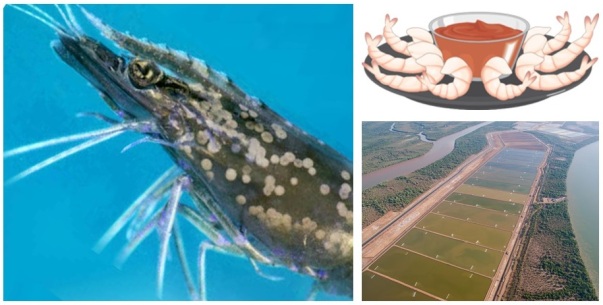Hello everyone and welcome back! Muppet treasure island is a movie I like a lot (you should check it out if you haven’t already haha), and in it there’s reference to the ‘black spot’. To a pirate, the black spot was a bad sign, and the recipient of said spot knew that they probably wouldn’t be alive for much longer. Well, today I’m going to talk about another spot, that is just as bad of a sign for some shrimp.

Whispovirus, a.k.a white spot, is the only genus of virus in the family Nimaviridae. This virus contains DNA and actually, a group (or complex) of viruses, called the Whitespot Syndrome Baculovirus complex, causes the disease called white spot syndrome. This virus particularly infects a specific type of shrimp (penaeid shrimp), although it can also infect other types of crustaceans. Characteristic white spots are created on the shell of the shrimp…and they also get sluggish and lose their appetite. We care about penaeid shrimp because many of them are consumed as food around the world, and a lot of money passes through many hands because of this industry. If you are a student, can you quickly research what other type of crustacean this virus affects?
In the early 1990s, there were reports of huge white spot outbreaks in Taiwan and China, causing a big problem for the shrimp farming business. Several other countries such as the United States, Saudi Arabia, India and Japan have all seen instances of outbreaks, with reports being made as recently as 2016 in Australia. What further makes this virus such a problem is that there is no current treatment for the disease, it is very contagious, it kills all the shrimp in a given location, and it does it fast! So fast in fact, that all the shrimp in a given shrimp farm could be wiped out within days!!
Well then…what can we do about this problem you ask? Prevention is key. So, it appears that penaeid shrimp like a relaxed life (like some people I know…haha), so, it’s a good idea to keep reared shrimp away from environmental stressors, which include big changes in temperature or salt content, or exposure to bacterial infections. Disinfectants can be used, and farmers are careful to avoid instances of contamination. Overall, it seems as though much research still needs to be done (hint hint to any budding scientists out there), to help discover treatments for shrimp white spot syndrome.
Take care until next time, and happy Earth Day! 😊
Follow the links to read more on white spot syndrome, and Penaeidae. Credit is given for use of images of white spot diseased individual, Mahajamba shrimp farm, and shrimp with sauce cartoon.
